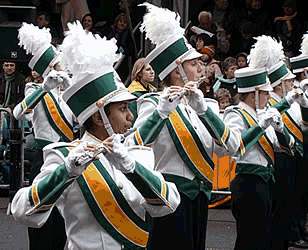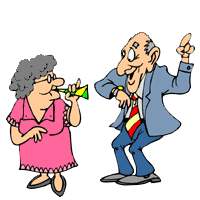The whole range of celebration of the New Year's Day basically stems from the various ways ancient societies used to greet the new harvest seasons. In fact, it is the number of harvests, whether of fruit or grain, that determined how many New Years were observed. The origins of the customs that we think of as peculiarly associated with the celebration of the New Year, took roots in the ways the ancient peoples regarded the New Year. Likewise the other ancient societies in other parts of the world, the New Year festivities had been observed in our wild forests and plains by the native Indians. To the Creek Indians the ripening of the corn in July or August signified the termination of one year and the beginning of another. It was their customs to drape themselves with new clothes, replace the old interiors and households.
The Iroquois, another native Indian tribe who inaugurated the new year in January, February or March with ceremonies emphasizing the expulsion of evil spirits. The customs of sporting disguise and masks, making noises and confessions were all practiced by them.
Symbolically, New
Year signifies a renewal of life. Hence, the spirit of celebration for the regeneration,
while discarding the old and worn out. The customs and practices, though modified
through the centuries, have still their distinctive strains in the ways we welcome
each onrushing year.
It was the Dutch, in their New Amsterdam settlement at
mid-17th century, who originated the modern American New Year celebration. The
New Year's Day was the most important holiday for the Dutch who were noted in
all the colonies for their love of beer and wine.
Given here are some instances of New Year's Day revelry with their historical trails:
The idea of making deafening noise is to drive away the evil spirits who flocked to the living at this climactic season with a great wailing of horns and shouts and beating of drums. This is why at the stroke of midnight we hear the deafening cacophony of sirens, car horns, boat whistles, party horns, church bells, drums, pots and pans - anything that serves the purpose of producing a devil chasing din.
The popular
Tournament of Roses Parade held on this day in Pasadena, CA, was started in 1886
by the Valley Hunt Club, whose members decorated their carriages with flowers,
creating what was meant to be " an artistic celebration of the ripening of the
oranges in California". In the afternoon athletic events were held. The city
of Pasadena later relieved the club of sponsorship of the parade, and the city
was in turn succeeded by the Tournament of Roses Association, which till date
directs the activities.
Pasadena later relieved the club of sponsorship of the parade, and the city
was in turn succeeded by the Tournament of Roses Association, which till date
directs the activities.
Gradually the flower-decked carriages gave way to
floats that by parade rules can be covered only with fresh flowers.
Yet another
annual attraction, the Rose Bowl football game, became part of the festivities
in 1902.
The traditional and spectacular Mummers' Parade of Philadelphia owes
its origin to the Christmas celebrations of the Swedes and the Englishmen who
settled along the Delaware River.
The masked revelers among the Swedes saw
to it that the festivities of the Christmas season lasted until the New Year.
The English brought with them their ancient practice of mumming. This, in America,
took the form of groups of men presenting costumed plays, going from house to
house reciting their parts in expectation of money or some of the Christmas fare.
It was since then the parade has been divided into three main sections: the fancy-dress
division, the clown division, and the string bands.
Yet another familiar
practice, though not quite encouraging. The unbridled drinking bash on the New
Year's Eve, is also a secular leftover of a rite that was once religious in character.
The original spirit has been a personal re-enacting of the chaotic world that
existed before the ordered cosmos was created by God.
also a secular leftover of a rite that was once religious in character.
The original spirit has been a personal re-enacting of the chaotic world that
existed before the ordered cosmos was created by God.
 In
order to have a 'clean slate' on which to start the New Year, people in times
past have made certain that they had all their borrowings cleared. Those were
the days before such complexities as credit buying. The New Year resolutions,
which we are so fond of, represent other efforts to make the year brand new. In
fact, we often say that in the New Year we are "turning over a new leaf."
In
order to have a 'clean slate' on which to start the New Year, people in times
past have made certain that they had all their borrowings cleared. Those were
the days before such complexities as credit buying. The New Year resolutions,
which we are so fond of, represent other efforts to make the year brand new. In
fact, we often say that in the New Year we are "turning over a new leaf."
It is traditionally thought that the first day of the year is symptomatic of the approaching 364 days. Accordingly, people try to spend the first day of the new year in the best possible way in the company of family and friends. It was once believed to be a good omen if a tall dark-haired man visits your house on New Year's Day. Traditional New Year foods are also thought to bring good luck. In many cultures, it is a predominant belief that anything in the shape of a ring brings luck, because it symbolizes "coming full circle," completing a year's cycle. It is primarily for this reason that the Dutch believe that eating donuts on New Year's Day brings good fortune. Black-eyed peas and other legumes have been considered good luck in many cultures. The hog, and thus its meat, is considered lucky because it symbolizes prosperity. Consuming cabbage is also considered a potential harbinger of good luck. In some regions, rice is a lucky food that is eaten on New Year's Day.
When they
eventually lost control of New Amsterdam to the English for the last time in 1674,
they had no trouble persuading the English to abandon their March 25 New Year
and observe it on January 1.
The principal customs of the day were visiting
friends and exchanging gifts, to which the English added the turkey shoot. But
in March 1773, the New York State legislature outlawed the firing of guns and
explosions.
 The practice of
visiting friends continued until the first years of this century. It was a gala
time when everyone held open house and laid out enormous feasts for any one who
should drop in, whether friend or stranger. To neglect this annual visit was a
terrible sight, and the roads were thronged with carriages bearing the holiday-makers.
The practice of
visiting friends continued until the first years of this century. It was a gala
time when everyone held open house and laid out enormous feasts for any one who
should drop in, whether friend or stranger. To neglect this annual visit was a
terrible sight, and the roads were thronged with carriages bearing the holiday-makers.
Unfortunately in time the custom was abused; the distinction between privacy and
sociability was ignored and troops of unwanted guests descended on the open houses,
using them as eating and drinking stations. Politicians and those with an eye
on the social ladder were said to have spread their blight over the purposes of
the day. People began to send invitations to special guests for their own protection,
and the old custom fell irretrievably into decline.
Thus the whole range
of ideas of purgation, purifications, the confessing of sins, driving off demons,
expulsion of evil out of the village and so on transpired. The idea remained the
same the abolition of the past. So is the case of masked processions - the
masks representing the souls of the dead. The ceremonial reception of the
dead, who are invited to feast and led back at the end of the feast to the borders
of the territory, to the sea, or the river, or wherever else, is also in line
with this concept. Add to these the interlude of Carnival, Saturnalia, reversal
of normal order. Though all these constitute the much familiar New Year revelry,
these are just part of the rites practiced by primitive man during the celebration
of their own New Years.
The ceremonial reception of the
dead, who are invited to feast and led back at the end of the feast to the borders
of the territory, to the sea, or the river, or wherever else, is also in line
with this concept. Add to these the interlude of Carnival, Saturnalia, reversal
of normal order. Though all these constitute the much familiar New Year revelry,
these are just part of the rites practiced by primitive man during the celebration
of their own New Years.